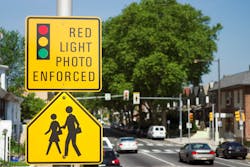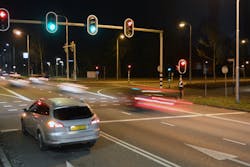How to Map Out Traffic Enforcement
Radar-based mobile speed cameras have been a valuable law enforcement tool for enhancing public safety since 1982. Red-light cameras have also been in use for quite some time, but while the placement and use are simple, it’s also quite restricted. They can only be placed at intersections with traffic lights and your agency can select the intersections where they’re most needed by identifying which intersections have the highest rate of accident occurrence. Speed cameras, being mobile, present a larger challenge for effective placement and optimal use.
Where and when you place the mobile speed cameras (MSCs) should be determined by examining a fair amount of available data. Thanks to the digitization of accident reports, citizen complaints, traffic saturation, and density reports from state highway administrations and more, the larger challenge probably is having too much data to sort through instead of not having enough. At a bare minimum, as you begin planning out your MSC use strategy, make sure you collect a few significant items of data.
With your strategy planned, you should communicate it to your patrol officers and any dedicated traffic enforcement officers. Nothing special should be done to keep them out of the targeted MSC enforcement zones, but it pays to remember that their visible presence will reduce speed violations out of balance as compared to "normal."
Hot spots
The “hot spots” in your jurisdiction are the locations of most of your traffic accidents. These include intersections, road curves, low visibility areas, etc. Keep in mind that it doesn’t matter if the accidents are single-vehicle accidents or involve multiple vehicles. Identify the top ten locations in your jurisdiction that account for the majority of traffic accidents. When you’re doing this research, don’t just use the accident reports, but also get a list of reported accidents from your emergency call center/computer records. Many traffic accidents don’t end up with a written report because no one is injured and all vehicles are still drivable.
Nuisance areas
The locations of the greatest concentration of citizen complaints. Whether we consider them accurate or not; whether we consider them a nuisance or not; the fact is that we do answer to the citizens we serve and the large majority of their complaints about speeding vehicles, reckless drivers, etc. are accurate. For the purpose of identifying high-risk areas for MSC placement, those citizen complaints need to be taken into consideration.
School zones
Make sure you include all of the school zones in your jurisdiction and see if you can prioritize them based on proximity to higher-speed highways or roads. Many schools are located in neighborhoods so the speed limit on the proximate roads is already 25MPH, but some schools are located on major thoroughfares or even state highways. In those locations, the speed limit could be 55MPH (or more) until the school zone border is reached and then the speed limit can drop to 35MPH (or less in some restricted cases). Those school zones located on or near the higher speed roadways are likely going to need special attention for speed enforcement.
After you’ve identified the school zones, get a report/list of the requests for added enforcement from your local school board. More often than not, you’ll likely find that their requests for targeted enforcement correspond with the schools located closer to the high-speed roadways. You’ll likely also find a great many requests for school zones located in the back neighborhoods that already have 25MPH speed limits. Keep in mind that speeding is speeding and while not proportionate, it can be observed as such. The person going 40MPH in a 25MPH zone can seem much faster than the person going 50MPH in a 35MPH zone. Both are 15MPH above the limit, but the speeds sure do look different to the mom on the sidewalk with her six-year-old on the way to school.
Selection
After you’ve gone through all of that data collection and analysis, you can cross-reference the material and easily select your target areas. Depending on how many mobile cameras you have, you should pick four to five that number of targets. For example, if you have four MSCs, you should pick 15 to 20 target spots. Along with all that data on accidents, complaints, schools, etc. you should also have information on what days of the week and what times present the biggest threats to safety.
If there is an area that you need information about but you aren’t getting data from reports, etc. there is a tool you can use from Kustom Signals called a Traffic Data Collection Unit. Once placed, the Traffic Data Collection Unit counts cars and speeds and provides you the data searchable by time frames, dates, etc. Like the MSCs, the Traffic Data Collection Unit is mobile and can be placed in numerous locations for a couple of weeks at a time to gather the data you need and enhance your strategic planning.
With your strategy planned, you should communicate it to your patrol officers and any dedicated traffic enforcement officers. Nothing special should be done to keep them out of the targeted MSC enforcement zones, but it pays to remember that their visible presence will reduce speed violations out of balance as compared to “normal.” Optimally, the MSCs should be used in coordination with targeted traffic enforcement.
One jurisdiction we spoke with while researching MSCs, said they use the cameras as a soft preparation for more strict enforcement efforts. They’d identify an area that needed some enforcement attention and place a message sign and a mobile speed camera. For the first week, a threshold was set so that people caught speeding by the camera, after having been warned by the sign received either warnings or violation letters, depending on their speed. For the second week, everyone caught speeding by the camera, above the programmed threshold, would receive violation letters.
After two weeks of enforcement efforts and clear communication to the drivers via a roadside message board, the MSC and message board would be removed, replaced with enforcement by officers during the identified high violation times. While the traffic enforcement officers are on assignment citing the speeders during the target hours, the MSC and message board used at that location can be moved to the next identified problem location. After the specified time of traffic enforcement assignment has passed, assuming there are enough MSCs available, one can be put back at the location that has just seen two to four weeks of targeted enforcement. The results from that MSC for a week after this period of targeted enforcement can be compared to the violation rate of vehicles in the first week and a measure of positive traffic safety improvement can be identified.
When the traffic enforcement officers have to go to court for the various citations they’ve issued (the ones that don’t get paid), part of their testimony is the two weeks of the message board and MSC use. If the violator in court was previously caught speeding by the MSC and a warning or violation letter sent, that should be included in the officer’s testimony as well.
With proper research, an effective strategy can be developed for the most efficient use of tools and personnel available. With proper documentation and records keeping during all enforcement activities, the positive impact of—or continued need for—speed enforcement in various target locations can be easily demonstrated with plenty of support documentation.
About the Author
Lt. Frank Borelli (ret), Editorial Director
Editorial Director
Lt. Frank Borelli is the Editorial Director for the Officer Media Group. Frank brings 20+ years of writing and editing experience in addition to 40 years of law enforcement operations, administration and training experience to the team.
Frank has had numerous books published which are available on Amazon.com, BarnesAndNoble.com, and other major retail outlets.
If you have any comments or questions, you can contact him via email at [email protected].


